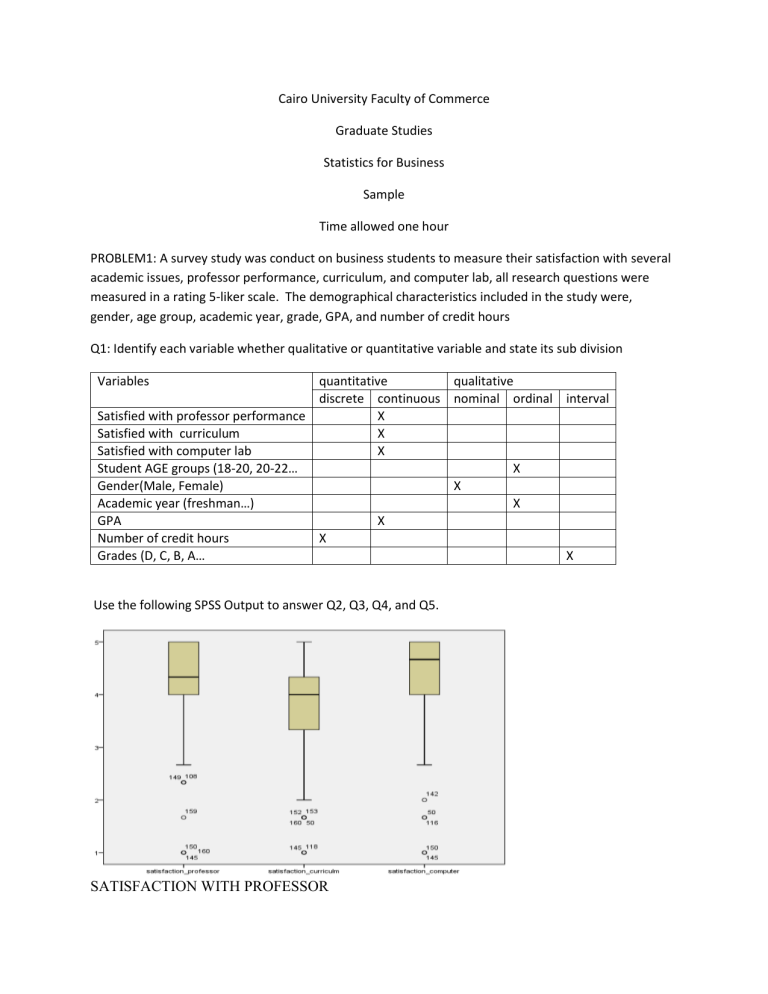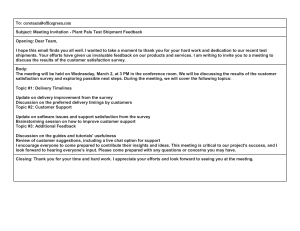
Cairo University Faculty of Commerce Graduate Studies Statistics for Business Sample Time allowed one hour PROBLEM1: A survey study was conduct on business students to measure their satisfaction with several academic issues, professor performance, curriculum, and computer lab, all research questions were measured in a rating 5-liker scale. The demographical characteristics included in the study were, gender, age group, academic year, grade, GPA, and number of credit hours Q1: Identify each variable whether qualitative or quantitative variable and state its sub division Variables quantitative qualitative discrete continuous nominal ordinal interval Satisfied with professor performance X Satisfied with curriculum X Satisfied with computer lab X Student AGE groups (18-20, 20-22… X Gender(Male, Female) X Academic year (freshman…) X GPA X Number of credit hours X Grades (D, C, B, A… X Use the following SPSS Output to answer Q2, Q3, Q4, and Q5. SATISFACTION WITH PROFESSOR The above boxplots illustrate the comparison between satisfactions of students with professor, curriculum, and computer lab. 1: Which distribution has the largest number of outliers? Satisfaction with professor and the curriculum 2: Describe each distribution, whether skewed to left, right, or symmetric. A:SATISFIED WITH PROESSOR: SKEWED TORIGHT B:SATISFIED WITH CURRICULM :SKEWED TO LEFT C:SATISFIED WITH COMPUTER :Skewed to left 3: Which distribution has more variability? Satisfaction with Curriculum 4: Which boxplot shows the highest median satisfaction? Satisfaction with computer lab 5: Which distribution has the smallest lower inner fence? 4. Problem2: The following tables provide 95% confidence intervals to the research questions. One-Sample Statistics N Mean Std. Deviation Std. Error Mean satisfaction professor 160 4.24 .815 .064 Satisfaction curriculum 160 3.78 .888 .070 satisfaction computer 160 4.30 .843 .067 One-Sample Test Test Value = 0 95% Confidence Interval of the Difference t satisfaction professor df Sig. (2-tailed) Mean Difference Lower Upper 65.758 159 .000 4.238 4.11 4.36 Satisfaction curriculum 53.778 159 .000 3.777 3.64 3.92 satisfaction computer 159 .000 4.296 4.16 4.43 64.489 Q1: Explain what the confidence interval of the research variables, say about their means satisfaction? Of Preprocessor, of Curriculum, of Computer lab . Research Variables 95% Confidence Interval Explanation satisfaction professor Satisfaction curriculum satisfaction computer Q2: Test at 5% level whether students are satisfied with professor performance? 𝐻0 : The average satisfaction is less than or equal (3=neutral) VS 𝐻𝑎 : The average satisfaction is more than (3 =neutral) Is the hypothesis one tailed or two-tailed test? What is the test statistic= t = _______ What the P-value_________ At𝛼 = 5% 𝑙𝑒𝑣𝑒𝑙 𝑜𝑓 𝑠𝑖𝑔𝑛𝑖𝑓𝑖𝑐𝑎𝑛𝑡, what is your decision regarding student satisfaction with professor? Q3: If I reject the above hypothesis that the average rating is 3 or less, when in fact it is 3 or less, then, I committed (a) Type I, error (b) Type II, error Q4: What is the power of the test means? Check one of the following -Is the probability of rejecting that the average is more than 3, when in fact the average is more than 3 -Is the probability of not rejecting that the average is 3, when infect it is 3. -Is the probability of rejecting that the average satisfaction is less than or equal 3, when in fact it is less than or equal three. -Is the probability that we reject, the average is less than or equal 3, Problem 3: The following output compares the research variables against their gender (male, female). Answer Questions: Independent Samples Test Levene's Test for Equality of Variances satisfaction professor Satisfaction curriculum satisfaction computer Equal variances assumed Equal variances not assumed Equal variances assumed Equal variances not assumed Equal variances assumed Equal variances not assumed t-test for Equality of Means Mean Difference Std. Error Difference 95% Confidence Interval of the Difference Lower Upper F Sig. t 1.332 0.25 2.234 158 0.027 0.285 0.128 0.033 0.538 2.268 158 0.025 0.285 0.126 0.037 0.534 1.445 158 0.15 -0.203 0.141 -0.481 0.074 1.455 156.431 0.148 -0.203 0.14 -0.479 0.073 0.928 158 0.355 -0.124 0.134 -0.388 0.14 -0.93 154.083 0.354 -0.124 0.134 -0.388 0.14 0.414 0.274 0.521 0.601 df Sig. (2tailed) Q1: Test if any significant differences between males variance and females variance in their satisfaction with Professor, curriculum, and computer lab. Testing for equality of variances: From the output Do male’s population and female population have the same variances: What is the p-value of the test? What are the p-values of the tests? Take the decisions at 5% level P-values Decision at 5% level 1. Profess Satisfaction ____________ 2. Curriculum Satisfaction__________ 3. Computer Lab Satisfaction Q2: Test for any significant difference between mean satisfactions of Males and Females and their perceptions to the research questions. What are the p-values of these tests? Take the decisions at 5% level P-values Decision at 5% level 4. Professor Satisfaction ____________ 5. Curriculum Satisfaction__________ 6. Computer Lab Satisfaction 1. ) support the same decision of the t-test (Comparing two means) above? Explain Problem 4: A possible Type II error would be to: (a) Conclude that the students are less fit (on average) than the general population when in fact they have equal fitness on average, . (b) Conclude that the students have the same fitness (on average) as the general population when in fact they are less fit on average. (c) Conclude that the students have the same fitness (on average) as the general population when in fact they are the same fitness level on average. (d) Conclude that the students are less fit (on average) than the general population, when, in fact, they are less fit on average. (e) Conclude that the students have the same fitness (on average) when in fact they are more fit on average. Problem 5: We want to test H0 : µ = 1.5 vs. H1 : µ ≠ 1.5 at α= .05 . A 95% confidence interval for µ calculated from a given random sample is (1.4, 3.6). Based on this finding we: (a) Fail to reject H0 . (b) Reject H0 . (c) Cannot make any decision at all because the value of the test statistic is not available. (d) Cannot make any decision at all because the distribution of the population is unknown. (e) Cannot make any decision at all because (1.4, 3.6) is only a 95% confidence interval for µ . Problem6: In order to compare two kinds of feed, thirteen pigs are split into two groups, and each group received one feed. The following are the gains in weight (kilograms) after a fixed period of time: Feed A: 8.0 7.4 5.8 6.2 8.8 9.5 Feed B: 12.0 18.2 8.0 9.6 8.2 9.9 10.3 T Group Statistics Feeds gains N Mean Std. Deviation Std. Error Mean 1 6 7.6167 1.44557 .59015 2 7 10.8857 3.49401 1.32061 Independent Samples Test Levene's Test for Equality of Variances F Sig. t-test for Equality of Means t df Sig. Mean Std. Error 95% Confidence Interval (2- Differenc Differenc of the Difference tailed) e e Lower Upper gains Equal variances 1.600 .232 -2.130- 11 .057 -3.26905- 1.53464 -6.64676- .10866 -2.260- 8.24 .053 -3.26905- 1.44648 -6.58770- .04961 assumed Equal variances not assumed 1



